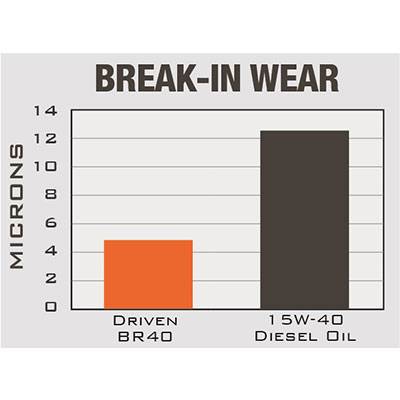
Driven Break-In Oil 15w-40
- Refundable Core Charge: "Cores" are used parts that can be used in re-manufacture. The Refundable Core Charge is added to your order and when you send your “core” in, we assess the value and will refund up to the Refundable Core Charge amount. +
- Regular Price Plus Core: $45.00 USD
DBR promotes proper surface mating during the critical break-in process and chemically assists with piston ring sealing. A low detergent level allows the “fast burn” ZDDP additive to adhere directly to all ferrous metal wear surfaces for maximum scuffing protection of flat tappet cams, bushing lifters, cam driven fuel pumps, turbocharger bearings and cylinder bores. Can be used in naturally aspirated and turbo diesel engines and is also safe for engines fitted with exhaust after-treatment devices. Viscosity typical of 15W-40.
What Is the Purpose of Break-in Oil?
Taking care of your engine from the get-go is required for maximum performance and life expectancy.
Break-in oil is specifically engineered to reduce accelerated wear - protecting your investment. Our break-in oils are high in zinc, providing better protection for your cylinder walls, drive gears, oil pump parts, and several other crucial engine components during break in.
By choosing not to use a break-in oil during the break in period, you’re setting your engine up for failure.
The Driven Difference in Break-in oil
Driven Racing Oil specializes in application specific chemistry. We utilize a very large concentration of a fast-acting zinc additive, which begins binding to the camshaft and lifters almost immediately.
Some oils might employ a different zinc additive package that does not bond as rapidly and may cause harm to the cam and lifters before the bonding process begins.
We also create break-in oils in a wide range of viscosities, making it easier to find one necessary for your engine needs.
Our team thinks with the mind of an engine builder. Just like building a competition engine, our break-in oils are developed to excel in the specific application.
When to Use Break-in Oil
Break-in oil is 100% recommended for new crate race engines or if you’ve changed considerable engine components. Generally, a break-in oil is necessary during the first 400-500 miles, but this can vary per application. Be sure to check with your manufacturer to get the proper break-in duration for your specific engine.
Break-In Oil vs Racing Oil vs Regular Oil
When it comes to breaking in a high performance engine, standard off-the-shelf oils won’t cut it.
These “stock” motor oils work for stock engines, but when you install a higher lift cam and stronger valve springs, you need a better oil. High performance engines see more RPM, higher loads and increased temperatures compared to stock engines, so a high performance engine requires higher levels of Zinc, Phosphorus, Sulfur and other additives to prevent increased wear.
Racing Oil is specifically designed to reduce wear and boost performance by increasing horsepower. They also contain friction modifiers to reduce friction and minimize light surface contact.
Break-in Oil, unlike regular racing oil, doesn't contain friction modifiers. That’s because an engine’s piston rings are exceptionally sensitive to low-friction lubricants during the break-in period. Moreover, break-in oil contains almost twice the amount of secondary zinc dialkyldithiophosphate (ZDDP) and is lower in detergent. The low detergent makes the increased ZDDP level to be more effective.
This kind of chemistry is what makes break-in oil superior while breaking in a new high performance engine.
Why Break In Oil Protects Your New Engine
Driven Break In Oil does not contain “magic molecules” or “proprietary technology”.
All oils lubricate, but the real question is how long will the oil lubricate and under what conditions? A gear oil is a terrible motor oil. Why? Because gear oils are designed for gears and differentials and motor oils are designed for engines. Different applications require different chemistries. Think about shoes. You could wear boots to run a marathon, but they won’t work very well. Shoes are designed for the application, and so are lubricants. That is why break-in oil works better for engine break-in than Diesel engine oil – application specific chemistry.


